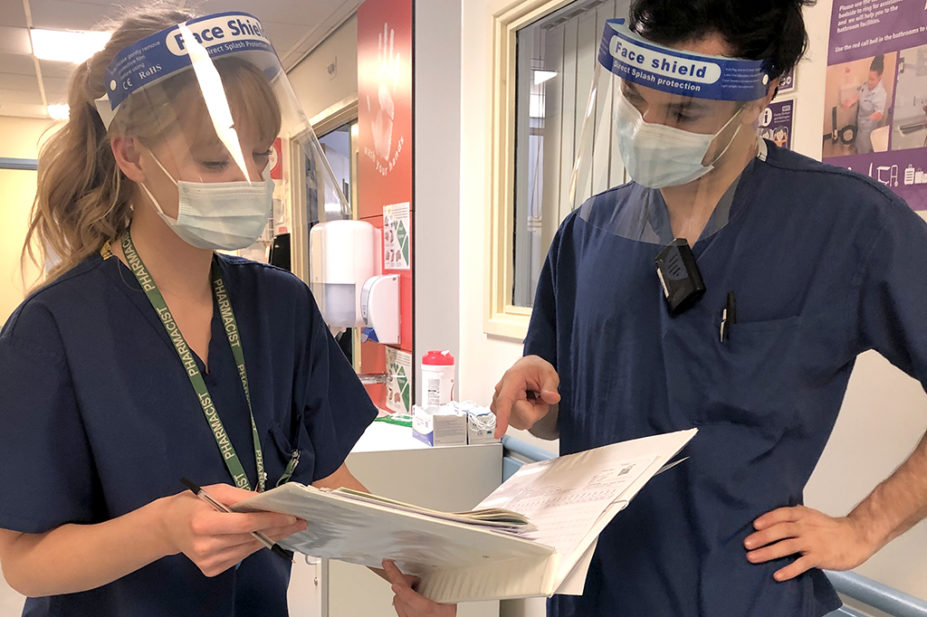
Fran Beavis
I started working at County Durham Darlington Foundation Trust (CDDFT) as a surgical pharmacist in 2016 and moved into a senior orthopaedic role in 2017.
As an independent prescriber, I provide medicines optimisation to both trauma and elective surgical patients, working closely with members of the multidisciplinary team (MDT) to ensure peri-operative medicines safety.
08:30 — start
I start my day meeting with other senior pharmacists to assess pharmacy team workload and re-allocate staffing where needed.
I then head to the orthopaedic and plastics trauma admission ward.
08:40
I use the electronic prescribing system to identify any new high-risk admissions and any critical medications omitted unintentionally overnight. Our pharmacy technician prioritises our workload and begins the medication reconciliation process with the aim of seeing all patients prior to surgery.
I notice a patient with a history of epilepsy has been scheduled for an elective procedure but was reported as being confused on admission. He has not brought in a supply of his medication and is unable to communicate his usual dose with the nursing or medical staff. I access his GP records, prescribe and supply the correct anti-epileptic to avoid delays in administration.
09:30
I attend the daily safety huddle for members of the ward MDT. This is an opportunity to hand over any outstanding patient medication issues, gather a list of planned discharges, identify post-operative complications and highlight the need for medication review.
I present the patients who require re-initiation of their anticoagulation and discuss any potential medication issues that may pose a barrier to discharge. I highlight insulin adjustment and blood glucose monitoring requirements for an insulin dependent patient who is awaiting surgery.
Prior to COVID-19, I would also attend the elective ward safety huddle to discuss any outstanding issues with the team, such as chasing up aspirate cultures for revision arthroplasty patients remaining on intravenous teicoplanin. However, my input is now provided remotely via electronic systems. Having good working relationships with the elective ward team also helps when communicating plans.
10:00
I screen inpatients planned for discharge from the orthopaedic ward and order any new medications in advance to ensure there are no delays.
There is a target for patients with a fractured hip to be admitted to the orthopaedic ward within four hours. If there are no spare beds on the ward, this will not be met, so pharmacy plays a vital role in maintaining patient flow and efficiency of discharges.
11:00
I review patients admitted overnight who have had a medicines reconciliation completed by the pharmacy technician.
One patient has a history of dementia, is taking warfarin for atrial fibrillation and was admitted following an unwitnessed fall sustaining a fractured hip. Her computerised tomography (CT) head scan shows no bleed and her warfarin has been successfully reversed for theatre with an international normalised ratio (INR) currently of 1.3 (target <1.5 to reduce bleeding risk during theatre).
I complete a CHADS2 score, which is 3, and check her blood results. Treatment dose enoxaparin is not indicated, and I prescribe the prophylactic dose. I add this patient to the anticoagulant board in the doctor’s office, which highlights plans and ensures post-operative follow-up.
I initiate our standard hip fracture prescribing pathway, making sure to switch morphine to oxycodone owing to a history of chronic kidney disease. The patient’s methicillin resistant Staphylococcus aureus (MRSA) screen is negative, so I discontinue the peri-operative daptomycin and initiate co-amoxiclav as per the trust’s antibiotic formulary. I assess the patient’s falls risk and make a series of recommendations to be discussed with the ortho-geriatrician consultant later. I complete a fracture risk assessment and request a vitamin D blood level, bone profile and thyroid function test. I liaise with the care home who confirm that, although the patient has dementia, there are no compliance or swallowing issues (particularly important if starting a patient on an oral bisphosphonate). I aim to initiate alendronate plus calcium/vitamin D supplementation once the bloods are checked.
11:30
I am approached by nursing and junior medical staff about intravenous administration of medications and general prescribing advice. I use my clinical knowledge and a range of local and national guidelines as references. As a senior pharmacist, I am involved in the development and review of trust guidelines and protocols so it is important to have a good awareness of current evidence.
12:00
A colleague calls to ask for advice about a patient with a history of fracture who is not currently on osteoporosis treatment. We discuss the patient’s history and blood results and identify that the patient is vitamin D deficient and has been prescribed omeprazole, increasing the risk of fracture.
I advise on an appropriate vitamin D loading regimen followed by maintenance treatment. I recommend discussing bisphosphonate therapy with the patient, including risks versus benefits, and suggest sharing the Royal Osteoporosis Society patient information leaflets to aid this discussion. I also recommend a review of the omeprazole, which was initiated several years earlier for reflux.
13:00
I check in with the rest of the surgical pharmacy team. We keep in touch throughout the day to help each other out if there is a particularly busy workload in one area.
During the COVID-19 pandemic, there has been less face-face contact with our colleagues owing to social distancing. I have found that supporting each other through an online group chat has ensured we still feel connected as a team and that no one feels isolated.
13:15
I electronically screen the prescription charts for newly admitted elective patients who have already had an over-the-phone consultation, including medicines reconciliation, as well as pre- and peri-operative medicines advice given by a pharmacy team member.
We prescribe these medications in advance of admission alongside post-operative analgesia, enoxaparin, laxatives, antiemetics and antibiotics (the enhanced recovery pathway). Prescribing in advance ensures appropriate peri-operative management and critical medications are not delayed. The anaesthetic and surgical team also have an accurate drug history and required analgesia is available immediately post-op.
14:00
I receive a phone call from the pre-operative assessment nurse who is requesting advice on a patient with a history of a neuroendocrine tumour requiring an octreotide infusion to prevent carcinoid syndrome. I research the dosing and administration and liaise with the tertiary centre specialist to clarify the details. I then organise with the anaesthetist and theatre ward manager an appropriate plan for administration and amend the patient’s slot on the theatre list to ensure suitable timing of surgery around the infusion.
I will assist with prescribing and administration on the day of surgery to support staff who are unfamiliar with this drug.
15:30
A patient diagnosed with a fractured hip is in A&E with a history of Parkinson’s disease and is due to be transferred to the ward imminently. I access the patient’s medication records and recent clinic letters, clarify the current regimen, confirm timings with the care home, ensure a supply is available on the ward and prescribe this on the drug chart.
I inform the admissions bay nursing staff of the time-critical medications to ensure administration. I also refer this patient to the Parkinson’s disease specialist team who can provide an inpatient review to optimise treatment and provide further advice. This patient will require close follow-up, particularly in the post-operative period when there may be an unsafe swallow and alternative treatment required.
15:50
The elderly care consultant attends the ward to review patients who are admitted with hip fractures. We discuss a patient who has been compliant with oral bisphosphonate treatment for eight years with sufficient vitamin D and calcium levels and normal thyroid function. We decide to refer the patient to the rheumatology team to consider alternative parenteral bone sparing therapy and order a repeat dual-energy X-ray absorptiometry (DEXA) scan to support the rheumatology treatment decision.
The consultant highlights another patient who he would like to initiate on intravenous iron and requests a suitable dose. I determine the patient’s weight, renal function and haemoglobin and I counsel the patient and prescribe an appropriate regime.
16:15
I review patients who are in their first few days post-op to assess if their bloods or observations require medication dose adjustment, discuss pain management with patients, and restart any medications that were withheld for theatre.
16:30
The surgeon identifies a patient admitted who takes dabigatran for atrial fibrillation and wants to know when this patient will be safe to operate on. I calculate the patient’s renal function, confirm the last dose and make reference to guidelines to provide advice.
17:00
Before I leave for the day, I ensure all warfarin is prescribed prior to the evening drug round, hand over to the doctors any additional bloods that I would like requested as they are writing out the blood forms for the next day, and ensure the electronic handover is fully updated ready for the following day.
Interested in a similar role?
- My role is NHS Agenda for Change Band 8a;
- Patients have input from a range of healthcare professionals, including medicines management technicians. It is vital that you get to know your team and their roles, as well as ensuring they know who you are and what support and advice you can provide;
- Ask lots of questions and read up on the common surgical terms and abbreviations used;
- Undergoing surgery can be a daunting time for patients. Ease their anxiety by updating them on medication changes and ensure they are given treatment choice;
- There is a constant flow of admissions and discharges — prioritising tasks and keeping your handover up to date helps to ensure nothing is missed.
You may also be interested in

‘Nothing compares to it’ — a day in the life of a child and adolescent mental health pharmacist

‘I help trainees get the most from their placement’ — a day in the life of a pharmacy preregistration training lead
